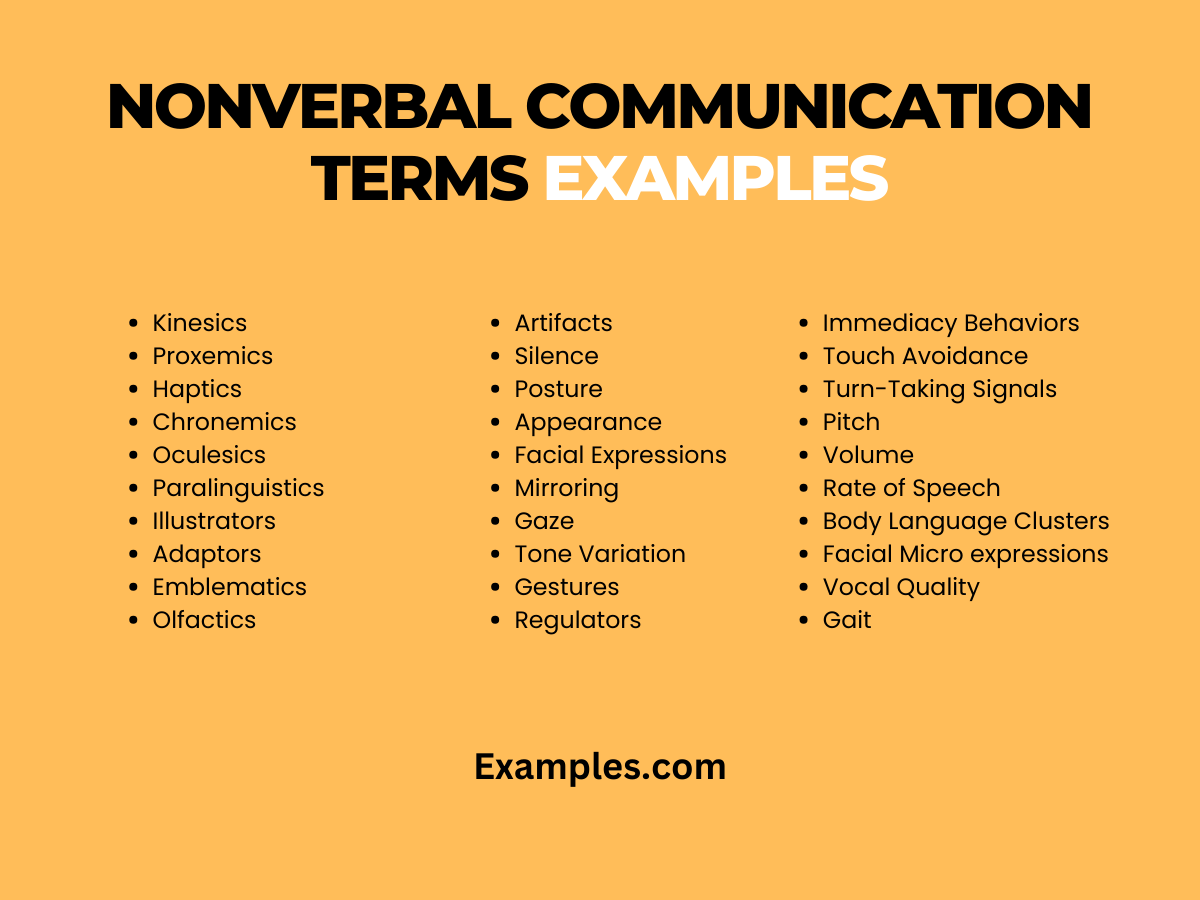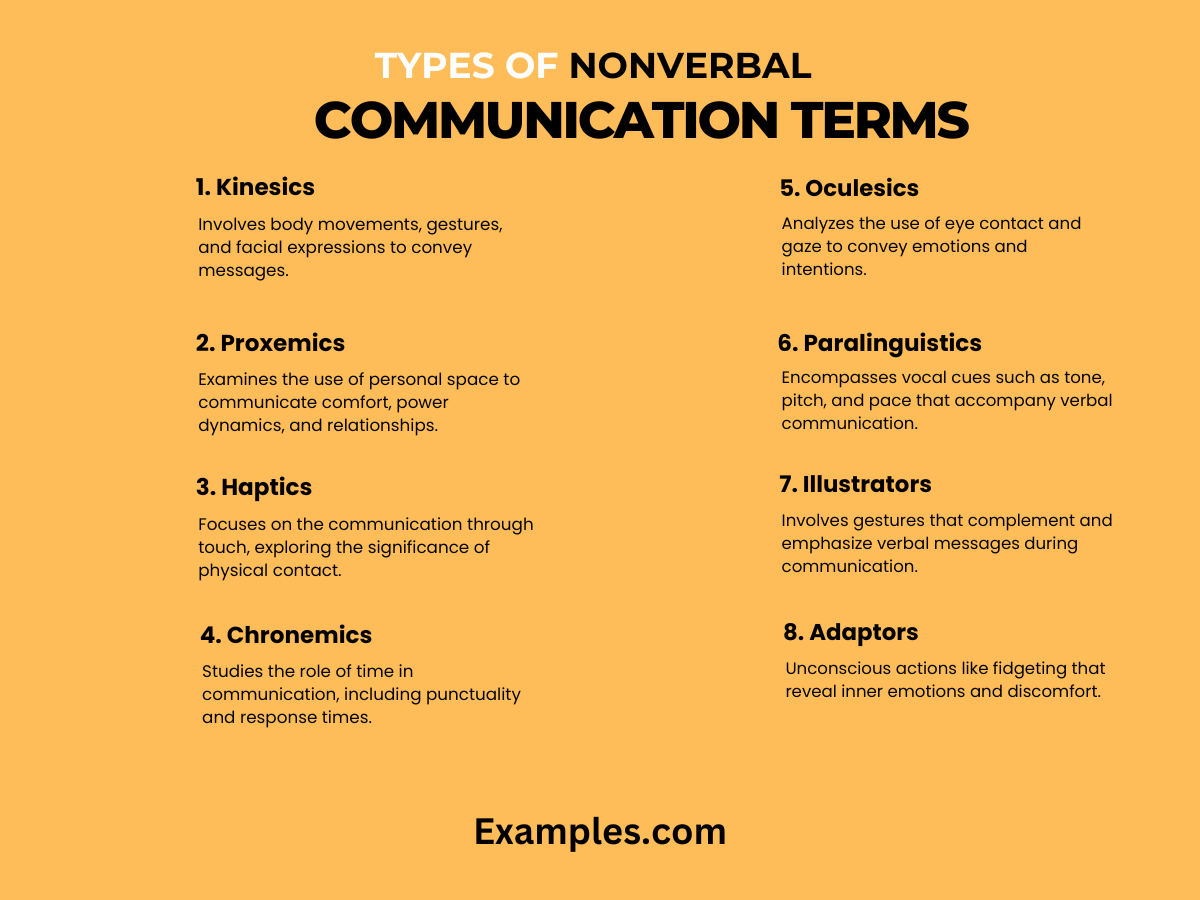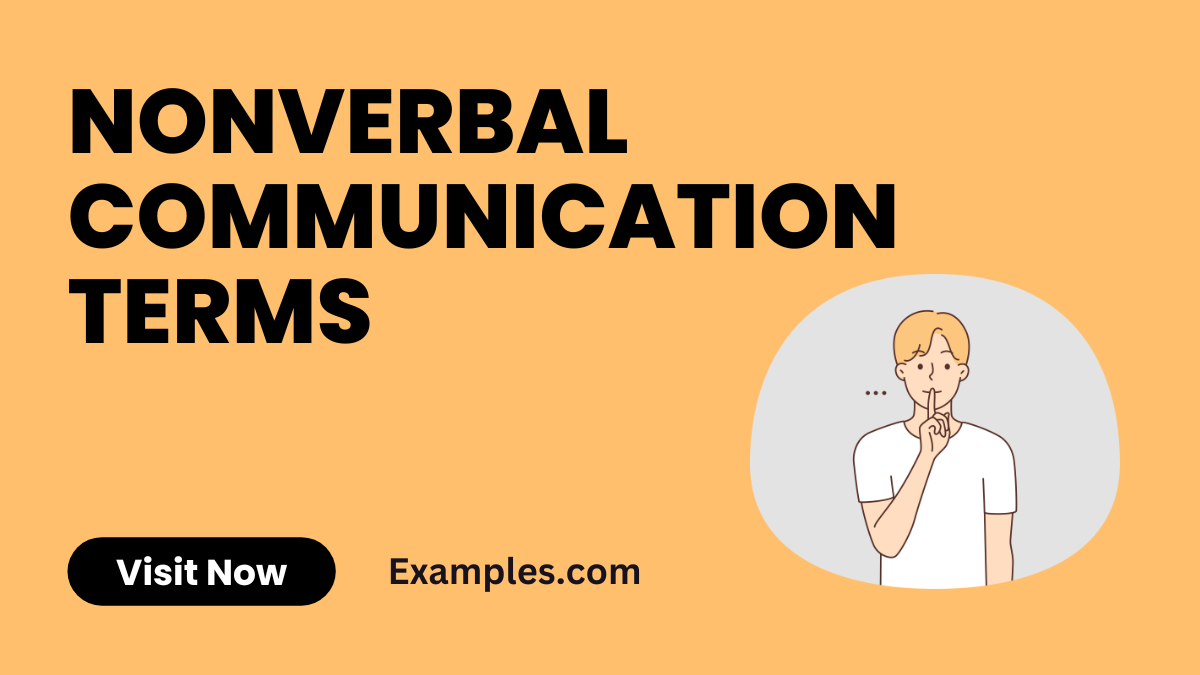29+ Nonverbal Communication Terms Examples
Unlock the secrets of effective communication with our comprehensive guide to Nonverbal Communication Terms. Delve into a rich array of Communication Examples that illuminate the unspoken language of gestures and cues. Enhance your understanding of this vital skill set and learn how to navigate the nuanced world of nonverbal interactions.
What are Nonverbal Communication Terms?

In simple terms, Nonverbal Communication involves conveying messages without words. It encompasses facial expressions, body language, and gestures, playing a pivotal role in interpersonal dynamics. Understanding these subtle cues is essential for cultivating effective communication skills and fostering meaningful connections.
30 Nonverbal Communication Terms Examples

Unlock the world of Nonverbal Communication Terms with these impactful examples. Master the art of silent communication with our diverse showcase, designed to enhance your understanding and fluency in nonverbal cues.
1. Kinesics: Understanding body movements is vital.
Example: Leaning forward during a conversation signifies interest, a key aspect of kinesics.
2. Proxemics: Examining personal space is crucial.
Example: Maintaining comfortable distance in a queue illustrates adept use of proxemics.
3. Haptics: Touch plays a role in communication.
Example: A warm handshake signifies friendliness and establishes a positive connection.
4. Chronemics: Time perception influences communication.
Example: Arriving punctually for a meeting reflects respect for others’ time.
5. Oculesics: Eye contact speaks volumes.
Example: Maintaining eye contact during a presentation conveys confidence and sincerity.
6. Paralinguistics: Tone and pitch matter.
Example: A cheerful tone can transform a casual greeting into a warm and friendly exchange.
7. Illustrators: Gestures complement verbal communication.
Example: Using hand movements to describe a story adds vividness to the narrative.
8. Adaptors: Unconscious actions reveal emotions.
Example: Nervously tapping fingers may indicate anxiety or impatience.
9. Emblematics: Symbolic gestures convey specific meanings.
Example: A victory sign symbolizes success and achievement.
10. Olfactics: Scents impact perceptions.
Example: Wearing a pleasant fragrance enhances a positive first impression.
11. Artifacts: Personal items convey identity.
Example: Wearing a badge at work signifies affiliation and role.
12. Silence: Pauses can convey powerful messages.
Example: A thoughtful pause during a debate adds weight to one’s argument.
13. Posture: Body alignment reflects attitude.
Example: Standing upright exudes confidence and professionalism.
14. Appearance: Clothing choices influence perception.
Example: Choosing formal attire for a job interview communicates seriousness.
15. Facial Expressions: Emotions are conveyed through faces.
Example: A genuine smile instantly creates a positive atmosphere.
16. Mirroring: Imitating gestures fosters connection.
Example: Mirroring a friend’s excitement enhances rapport in social situations.
17. Gaze: Direction of the eyes communicates focus.
Example: Directing gaze towards a speaker shows active engagement.
18. Tone Variation: Modulating voice adds depth.
Example: Using a confident tone during a presentation captivates the audience.
19. Gestures: Hand movements convey emphasis.
Example: Pointing at a map clarifies directions in a nonverbal manner.
20. Regulators: Signals for turn-taking in conversation.
Example: Nodding signals agreement and encourages the speaker to continue.
21. Immediacy Behaviors: Openness enhances connection.
Example: Maintaining an open posture fosters approachability.
22. Touch Avoidance: Respecting personal space.
Example: Politely declining a hug respects boundaries and demonstrates touch avoidance.
23. Turn-Taking Signals: Nonverbal cues for smooth conversations.
Example: Brief pauses signal readiness for a conversational exchange.
24. Pitch: Voice pitch conveys emotions.
Example: A high-pitched voice may convey excitement or surprise.
25. Volume: Controlled volume enhances clarity.
Example: Speaking softly in a library demonstrates awareness of the environment.
26. Rate of Speech: Varied pace adds dynamism.
Example: Quickening speech during storytelling maintains audience engagement.
27. Body Language Clusters: Combinations convey complex messages.
Example: Crossed arms, raised eyebrows, and a tilted head may indicate skepticism.
28. Facial Microexpressions: Brief expressions reveal hidden emotions.
Example: A fleeting frown may betray momentary discomfort.
29. Vocal Quality: Tone and texture impact communication.
Example: A soothing vocal quality can diffuse tension in challenging discussions.
30. Gait: Walking style reflects personality.
Example: Confident strides exude self-assuredness in various social settings.
Nonverbal Communication Terms Examples for Students
Unlock the power of nonverbal cues in the academic realm with these essential examples. From attentive eye contact to expressive gestures, students can master the art of communication beyond words. Explore how these terms enrich interactions within the student community.
- Eye Contact: Establishing eye contact during class discussions promotes active engagement and demonstrates respect for the speaker.
- Gesture Recognition: Students can enhance group projects by recognizing and utilizing appropriate gestures to convey ideas effectively.
- Posture Awareness: Maintaining an upright posture in the classroom conveys attentiveness and a readiness to learn.
- Facial Expressions in Learning: Expressive facial cues, like a smile during a lesson, create a positive and encouraging learning environment.
- Mirroring Peers: Mirroring classmates subtly fosters camaraderie and a sense of connection within the student community.
- Vocal Variety: Students can captivate their audience during presentations by varying tone and pitch for emphasis.
- Personal Space Etiquette: Respecting personal space in group activities ensures a comfortable and cooperative learning atmosphere.
- Visual Aids Gesturing: Incorporating purposeful gestures while using visual aids enhances the clarity of explanations during presentations.
- Turn-Taking Signals: Nonverbal cues, such as nodding, facilitate smooth turn-taking in classroom discussions.
- Seating Arrangement Awareness: Understanding the impact of seating arrangements on communication helps students choose conducive group settings.
Nonverbal Communication Terms Examples in Sports
Explore the dynamic role of nonverbal communication in the world of sports, where gestures, body language, and team dynamics are vital for success. Athletes can elevate their performance and teamwork by mastering these essential nonverbal communication terms.
- Celebratory Gestures: Teammates can boost morale by incorporating synchronized celebratory gestures after successful plays.
- Coach-Athlete Nonverbal Signals: Coaches use subtle cues to guide athletes during games, fostering a unique nonverbal communication channel.
- Body Language in Victory: A triumphant posture after scoring communicates confidence and reinforces team spirit.
- Defensive Stance Nonverbal Cues: Nonverbal signals, like a determined defensive stance, enhance coordination and readiness among players.
- Eye Contact in Team Huddles: Maintaining eye contact during strategic discussions promotes unity and focus within the team.
- Facial Expressions during Challenges: Nonverbal cues, such as determined facial expressions, inspire teammates to persevere during challenging moments.
- Gesture-Based Play Calls: Teams can implement efficient play communication through synchronized, gesture-based signals.
- Posture in Sportsmanship: Displaying respectful posture during competitions reflects sportsmanship and garners respect from opponents.
- Vocal Variations in Communication: Athletes can convey urgency or encouragement through variations in vocal tone during gameplay.
- Synchronized Movements: Coordinated movements between players, like synchronized jumps or passes, enhance team cohesion and effectiveness.
Nonverbal Communication Terms Examples at Work
Unlock the power of nonverbal cues in the professional arena. Explore how Nonverbal Communication Terms shape workplace dynamics, from effective team collaboration to assertive leadership. Mastering these nuances can enhance your professional presence and foster successful interactions within the workplace.
- Chronemics at Meetings: Starting a meeting promptly communicates respect for everyone’s time, setting a positive tone for collaboration.
- Oculesics in Presentations: Maintaining eye contact during a presentation establishes credibility and engagement with your audience.
- Proxemics in Office Layout: Arranging desks to provide personal space balances collaboration and individual focus in the workplace.
- Haptics in Handshakes: A firm handshake conveys confidence and professionalism, leaving a lasting impression in business interactions.
- Kinesics in Negotiations: Using open body language during negotiations fosters a sense of trust and openness.
- Paralinguistics in Team Discussions: Varying your tone and pitch adds enthusiasm and emphasis during team discussions, promoting active listening.
- Illustrators in Idea Expressions: Using hand gestures to illustrate ideas adds clarity and engagement in workplace discussions.
- Posture in Leadership: Maintaining an upright and open posture exudes confidence and leadership qualities in a professional setting.
- Turn-Taking Signals in Meetings: Subtle cues like nodding or brief pauses signal readiness for contributions, promoting balanced discussions.
- Gestures in Cross-Cultural Communication: Understanding cultural nuances in gestures prevents misinterpretation, fostering effective global communication in the workplace.
Types of Nonverbal Communication Terms

Understanding the various facets of nonverbal communication is crucial for effective interpersonal dynamics. Here, we delve into key types, offering insights into the intricate world of nonverbal cues.
| Type | Description |
|---|---|
| 1. Kinesics | Involves body movements, gestures, and facial expressions to convey messages. |
| 2. Proxemics | Examines the use of personal space to communicate comfort, power dynamics, and relationships. |
| 3. Haptics | Focuses on the communication through touch, exploring the significance of physical contact. |
| 4. Chronemics | Studies the role of time in communication, including punctuality and response times. |
| 5. Oculesics | Analyzes the use of eye contact and gaze to convey emotions and intentions. |
| 6. Paralinguistics | Encompasses vocal cues such as tone, pitch, and pace that accompany verbal communication. |
| 7. Illustrators | Involves gestures that complement and emphasize verbal messages during communication. |
| 8. Adaptors | Unconscious actions like fidgeting that reveal inner emotions and discomfort. |
| 9. Emblematics | Focuses on symbolic gestures that carry specific meanings within a cultural context. |
| 10. Olfactics | Explores the communication through scents and smells, influencing perceptions and interactions. |
How Do You Describe Nonverbal Communication Terms?
Describing nonverbal communication terms involves recognizing and articulating the nuanced elements that constitute this intricate form of expression.
- Observation: Pay close attention to body language, gestures, and facial expressions during interactions.
- Context Awareness: Consider the environment and cultural context, as nonverbal cues may vary significantly.
- Emotion Recognition: Identify emotional cues conveyed through tone, facial expressions, and body movements.
- Subtleties in Tone: Differentiate between variations in tone, pitch, and pace to understand underlying emotions.
- Spatial Awareness: Recognize the use of personal space and how it influences communication dynamics.
- Cultural Sensitivity: Understand that gestures and expressions may carry different meanings in diverse cultural settings.
- Consistency: Note if nonverbal cues align with verbal messages for a more accurate interpretation.
- Adaptability: Acknowledge that individuals may have different comfort levels with nonverbal communication.
- Feedback Reception: Be receptive to nonverbal cues as feedback during conversations to enhance understanding.
- Reflective Practice: Regularly reflect on your own nonverbal cues to improve communication and build self-awareness.
Describe the Most Important Aspects of Nonverbal Communication Terms
Nonverbal communication terms encompass a myriad of elements crucial for effective human interaction. Understanding kinesics, proxemics, haptics, and more is essential. These aspects influence how individuals perceive and convey messages without words. Dive into the nuances of facial expressions, body language, and gestures. Explore the impact of proxemics on personal space and the significance of eye contact. Uncover the richness of nonverbal communication terms, unlocking the subtle cues that shape interpersonal connections.
Tips for Effective Nonverbal Communication Terms
- Master Body Language: Understand and align gestures, posture, and facial expressions with your message for cohesive communication.
- Adapt to Cultural Differences: Recognize varying nonverbal cues across cultures to avoid misunderstandings in diverse settings.
- Eye Contact Matters: Convey confidence and engagement through appropriate and maintained eye contact in conversations.
- Use Proxemics Wisely: Be mindful of personal space, adjusting proximity for comfort and respect in different interactions.
- Modulate Your Voice: Emphasize points and convey emotions by varying tone, pitch, and volume in verbal communication.
- Gesture with Purpose: Enhance clarity by purposefully using hand gestures that complement verbal messages.
- Dress for the Occasion: Your attire contributes to nonverbal cues; dress appropriately to align with professional expectations.
- Be Mindful of Time: Punctuality contributes to a positive nonverbal impression in various situations.
- Practice Active Listening: Demonstrate attentiveness through nods, facial expressions, and mirroring during conversations.
- Embrace Mirroring and Matching: Foster connection by subtly mirroring others’ body language for understanding.
In the realm of nonverbal communication, understanding the subtle cues and gestures that constitute this form of interaction is crucial. The comprehensive guide on Nonverbal Communication Terms demonstrates the significance of elements like kinesics, proxemics, haptics, and more in shaping how we perceive and convey messages beyond words. For further exploration into the realm of nonverbal communication, the American Psychological Association (APA) offers extensive research and insights. Their website (APA) provides valuable resources on psychological aspects of nonverbal communication, enhancing understanding in various interpersonal contexts.
Additionally, the National Communication Association (NCA) provides a wealth of resources and scholarly articles on different facets of communication, including nonverbal aspects. Their resources can significantly enhance one’s understanding of the nuances and complexities of nonverbal communication in personal and professional settings. Conclusively, mastering nonverbal communication is not just about recognizing these terms but applying them effectively in everyday interactions. This skill set enhances interpersonal dynamics, fosters meaningful connections, and ensures that our unspoken language aligns with our intentions and emotions.



